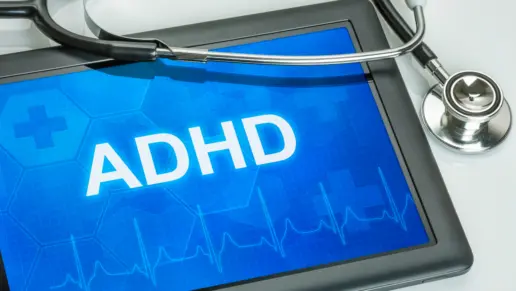Conduct disorder and substance use disorders are mental health conditions. The Fifth Edition of the American Psychiatric Association’s Diagnostic and Statistical Manual of Mental Disorders (DSM 5) defines the criteria for diagnosis.
Adolescents Who Have Co-Occurring MDE & SUD (2023)
Out of 84.5 million adults with either condition, 20.4 million were diagnosed with both.
Each year, the Substance Abuse and Mental Health Services Administration (SAMHSA) does a national survey on drug use and health.
The 2023 survey reveals information about the diagnosis and treatment of co-occurring disorders in adolescents and adults. This information is crucial since treatment for co-occurring disorders requires specialized care by experienced mental health professionals who are skilled in this field.
The survey determined that in many cases adolescents were diagnosed with a major depressive episode (MDE) or substance use disorder (SUD) but not both. In the survey, they found that 5.9 million adolescents had either an MDE or SUD and 856,000 (14.5%) had both. In the same year, the survey found that 84.5 million adults had either a SUD or another mental illness and 20.4 million (24.1%) had both.
Data from 2021 and 2022 reveal these percentages have remained relatively stable. In 2021, the data show that 14.8% of adolescents had an SUD and co-occurring MDE and 23.5% of adults had an SUD and any mental illness. In 2022, this report reveals that co-occurring MDE and SUD in adolescents was 15.1% of the cohort surveyed and in adults it was 25.5%.
These statistics do not specifically identify adolescents or adults with a conduct disorder but they do reveal that co-occurring mental health conditions with a substance use disorder are not uncommon. Individuals with a dual diagnosis must receive simultaneous, integrated and coordinated treatment for these conditions to have the best chance of a good outcome.
What Is Conduct Disorder?
Conduct disorder is a mental health condition in which a person experiences a consistent pattern of behavior that violates societal norms and the rights of others. It’s more commonly diagnosed in children and adolescents but can continue into adulthood.
Common Symptoms
- Bullying or aggression
- Lying or theft
- Truancy or running away
- Vandalism or property destruction
- Lack of empathy or remorse
Conduct disorder symptoms may include aggressive, deceitful or destructive actions. People with a conduct disorder may display behaviors like bullying, physical aggression, theft, truancy or vandalism.
It is not uncommon for a person to lack empathy or concern for the impact their actions have on others. Diagnosis of conduct disorder differentiates between childhood-onset which occurs before age 10 and adolescent onset which is diagnosed after age 10.
The severity of contact disorder symptoms can vary, ranging from mild cases in which a person exhibits minor rule violations to severe cases that involve physical harm or significant property damage.
The condition can co-occur with other mental health disorders such as anxiety, depression, attention deficit hyperactivity disorder (ADHD) or SUD. The exact causes are not known but researchers believe that several factors contribute to developing symptoms. These factors include inconsistent parenting, exposure to violence in childhood and genetic and neurological influences.
Conduct disorder is diagnosed more commonly in males. Early identification and treatment are critical to prevent the condition from escalating and worsening. The symptoms of conduct disorder can significantly impede a person’s ability to function in family, social and educational settings.
This leads to long term challenges that can result in poor academic and work performance, loss of relationships, social isolation and interactions with the criminal justice system.
What Is a Dual Diagnosis or a Co-Occurring Disorder?
Dual diagnosis is also known as a co-occurring disorder. This refers to the simultaneous presence of a mental health condition and a substance use disorder. These conditions typically interact in complex ways, often exacerbating each other and making diagnosis and management more challenging.
Common Mental Health Conditions in Dual Diagnosis
- Depression
- Anxiety
- Bipolar disorder
- (Other mental health disorders may also co-occur)
Types of Substance Use Disorders
- Alcohol
- Illicit drugs
- Prescription medications
For example, a person with depression may use alcohol to self medicate. However, substance abuse can worsen depressive symptoms causing a person to spiral and use more alcohol to alleviate their symptoms of depression.
Several mental health disorders are commonly associated with dual diagnosis. These include depression, anxiety and bipolar disorder. These are more commonly found but the occurrence of other mental health conditions does happen.
Substance use disorders can involve illicit drugs, prescription medications or alcohol. The prevalence is significant since substance use and mental health issues often share some of the same risk factors such as genetic predisposition, trauma or environmental stressors.
Adolescents and adults with co-occurring disorders can experience heightened symptoms, which can decrease their commitment to following the treatment plan and increase the difficulty in achieving long-term stability as compared to someone with a single diagnosis.
Treatment must be delivered simultaneously through an integrated recovery for SUD and co-occurring mental disorders. This ensures that both mental health and SUDs are addressed in tandem since focusing on one without the other is unlikely to yield suitable results.
Comorbid Conduct Disorder and Substance Use Disorders
Comorbid presentation of conduct disorder and substance use disorder represents a significant challenge and requires specialized care for good outcomes.
Adolescents and young adults with conduct disorder have a higher risk of developing SUD because of difficulties with impulsivity, poor decision making and a tendency toward risk taking behaviors. These conditions may share risk factors such as genetic predisposition, exposure to trauma and environmental influences.
In 2023, a study in Kenya youths looked at the prevalence of conduct disorder diagnosis and the presence of other mental disorders. They found that a conduct disorder diagnosis was significantly associated with other mental health conditions including SUD, social phobia, antisocial personality disorder and obsessive compulsive disorder.
In both conditions young adults and adults frequently experience heightened interpersonal conflicts, legal problems, academic issues and an increased risk of antisocial behavior in adulthood. This comorbidity is concerning because each condition amplifies the severity of the other.
For example, diagnosed substance use disorder criteria can increase aggression and impulsivity which further entrenches conduct disorder behaviors. Conversely, conduct disorder behaviors can hinder a person’s ability to make sound judgments about substance use.
A 2019 evidence-based report of bidirectional SUDs and co-occurring mental disorders in the United States looked at children and adolescents who were hospitalized for conduct disorder and found they had a higher risk of comorbid substance use disorders compared to other psychiatric illnesses.
The most commonly abused substances were cannabis, tobacco and alcohol. This effect of increasing the risk of substance use disorder appears to weaken and diminish by age 21 for these substances. However the risk continues to be high for those over 21 to begin using cocaine, amphetamines, inhalants and club drugs.
Another article seems to suggest that adolescents with conduct disorder and a co-occurring SUD may have difficulty regulating their behavior because of changes in the brain’s default mode network (DMN) which regulates self-reflection and future thought.
The results suggest that these comorbid conditions are characterized by atypical brain activity that may increase the difficulty of achieving successful sobriety and emotional regulation. While further research is needed on a larger cohort to confirm these results, it also highlights the need for a coordinated and simultaneous treatment approach to achieve the best results.
Treating Addiction and Conduct Disorder
In the 1980s and ’90s, the emphasis on diagnosing conduct disorder may have delayed the development of public health policies and programs that could help address the co-occurring substance abuse.
Yet significant progress has been made since then which has affected policies in developing community based substance use disorder prevention programs, supportive and transitional housing and the recognition and integration of dual diagnosis treatment rehabilitation centers.
Changes in policy and treatment protocols are preceded by evidence-based research. A recent review of 935 research articles on dual diagnosis and treatment showed an increasing number of studies rising from the mid-1990s which peaked by 2012 and followed a steady state until 2022.
SUD Programs Met Dual Diagnosis Criteria (2014)
By 2014, a review of 256 U.S. programs revealed that 18% of substance use disorder programs and 9% of mental health programs met the criteria for dual diagnosis treatment. This was a significant leap considering that dual diagnosis treatment centers require clinicians with specialized training and experience to address the unique needs of persons with a dual diagnosis.
Significant changes also had to occur within programs involving organizational and financial changes at the policy level and structural changes at the treatment level to accommodate people with serious mental illnesses including disorders resulting in functional impairment that limits a person’s major life activities.
Researchers continue to make breakthroughs in identifying factors that influence the development of these disorders which can lead to improvements in treatment. For example a 2023 NIH study revealed there are commonly inherited genes across addiction disorders regardless of the substance to which a person is addicted. This can lead to more effective prevention and treatment strategies.
Therapies and Treatment Options for Co-Occurring Disorders
Co-occurring disorders require integrated treatment. Effective care combines evidence-based therapies that are tailored to your unique needs. This ensures that the mental health and behavioral health issues are treated simultaneously. Cognitive behavioral therapy (CBT) is the cornerstone treatment for co-occurring disorders.
CBT helps people identify and change negative thought patterns and behaviors that contribute to both SUD and conduct disorder. CBT treatment for conduct disorder may include strategies for impulse control and improving social skills while CBT for SUD focuses on identifying triggers and developing healthier coping mechanisms.
Dialectical behavior therapy (DBT) is another effective evidence based treatment used in dual diagnosis treatment centers. It is a subtype of cognitive behavior therapy. DBT is particularly effective for the treatment of severe emotional dysregulation. It provides tools for managing stress, improving interpersonal relationships and reducing harmful behaviors including substance abuse.
Family therapy addresses the dynamics in the family unit that play a significant role in the development and maintenance of both disorders. Strengthening family communication and creating a supportive home environment are key aspects of using this approach to treatment.
Medication assisted treatment (MAT) may be used to manage substance use disorders. This is particularly effective in the treatment of opioid use disorder and alcohol abuse. FDA approved prescribed medications help reduce withdrawal symptoms and cravings which can interfere with psychosocial therapy during ongoing treatment.
Using an integrated approach with these therapies to address the mental health concerns that trigger conduct disorder and substance use disorder helps improve long-term outcomes leading to sustainable SUD recovery and control of conduct disorder symptoms.
Finding a Drug Rehab Near You
Finding the right dual diagnosis rehabilitation center can be a life-changing decision. If you take a few steps and carefully consider your needs then you can begin a successful recovery journey for yourself or a loved one. An effective program should provide integrated care that simultaneously treats both conditions using evidence-based therapies and a coordinated approach.
Searching websites like this one that allow you to identify rehab facilities in your local area is a good place to start. You learn more about what the treatment center provides, read reviews and testimonials from past patients and find out more about the clinical services and programs provided at the facility.
If you’re searching for treatment for an adolescent, be sure the center offers specialized programs for this age group since treatment is significantly different for teenagers than it is for adults.
Look for licensed and accredited facilities. Your insurance provider will likely not pay for treatment at a program that is not licensed by the state. Accreditation by organizations such as the Joint Commission or the Commission on Accreditation of Rehabilitation Facilities (CARF) validates that the treatment center adheres to high standards of care.
Call the treatment center and schedule a tour to get a feel for the environment, meet the therapists and discuss insurance options with the financial counselor. Ask about their approach to dual diagnosis care.
They should offer evidence-based therapies and provide customized treatment plans. Look for comprehensive services that include treatment for co-occurring conditions, relapse prevention and address aftercare planning. Choosing a dual diagnosis treatment center with a strong reputation and tailored services can significantly improve treatment outcomes.
Addiction Centers That Treat Dual Diagnosis
Finding facilities near you…





